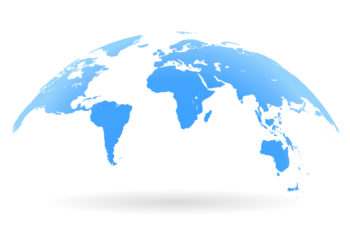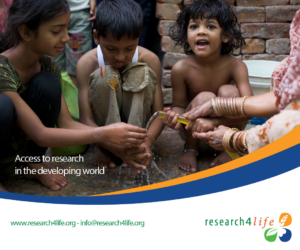Research4Life (R4L) has recently launched its new strategic plan. Although such plans are usually prepared for a five-year span, this time around the strategy instrument outlines a vision for 2030. R4L essentially started the strategy formulation process about three years ago by commissioning several assessments. I was involved in one of them, the Research4Life User Review, as a member of the INASP study team.

To me the new R4L strategy is an exciting one, not only because of the amount of effort that was put into gathering evidence before preparing it, but also for three other reasons. First, over the past 20 years, R4L has evolved into an influential platform bringing together five UN agencies, more than 200 publishers, two top universities of the world, and several technical partners to support the Global South’s to access research. Second, R4L currently benefits hundreds and thousands of researchers in over 10,500 institutions located in more than 125 countries who are accessing more than 163,000 journals and books. The estimated worth of this access is more than US$ 48 million per year. My country, Bangladesh, hosts 481 institutions (as of 2021), which is surpassed only by Nigeria (705) and Nepal (592). It was simply amazing to listen to librarians and researchers express how they appreciated R4L as I was conducting the R4L users’ interviews. So, it was no surprise when researchers said R4L was very valuable for their careers (97% of respondents), for their research skills (86%), and for their research quality (87%) as well as quantity (78%).
Third, since the inception of R4L in 2002, many positive and not-so-positive developments have taken place in the scholarly publishing sector: open access and preprints are changing the still predominantly subscription-based journal publishing landscape; predatory journals and piracy against paywall-restricted journals remains a concern; infrastructural advancements are transforming publishing workflows and journal access, making the whole system almost paperless; and the focus on sustainable development as well as DEIA (Diversity, Equity, Inclusion, and Accessibility) has gained significant traction in the publishing industry. It’s therefore quite natural to expect some significant shifts in R4L’s strategy as the organization enters in its third decade.
R4L’s new strategy aims to work towards, “An inclusive, diverse and equitable scholarly communications environment that enables all global researchers to address societal challenges”. The impact R4L wants to make as a part of its theory of change is that, “Lower income country researchers are actively participating in research communications by publishing in peer reviewed journals, including Open Access, and are fully represented across editorial roles in publications worldwide, experiencing a level playing field.” The organization has clearly identified a number of areas it will work on: improving research access ― R4L’s foundational niche ― by making the existing infrastructure robust, ensuring equitable engagement of Southern researchers in open access shifts, developing librarians’ and researchers’ capacity, and ensuring organization’s financial sustainability, among others. But I believe, time-tested ventures like R4L ― which started working in the arena of DEI or DEIA well before it became a familiar acronym ― should be bolder and more ambitious with their strategies and actions. They should influence the Southern national and regional research systems and start measuring the changes.
R4L can do so by bringing about some programmatic changes as it translates its new strategy into an action plan ― the next logical step after adopting a strategy. First, the countries of the Global South need some fundamental changes in the way they perceive their research systems. These countries are investing money ― from domestic revenues and foreign loans as well as grant receipts ― in a wide range of sectors as their per capita income and national GDP continue to grow. Then, why shouldn’t a proportionate increase in investment, especially from the internal funds, to access and conduct research and to build necessary capacity be a national priority? R4L’s global partners have been allocating modest amounts every year to support and improve R4L’s infrastructure and services. R4L has also been working hard with open-access-journal publishers for adopting and implementing an article processing charge (APC) waiver/discount policy for the eligible countries. Shouldn’t all R4L-eligible countries or their institutions ― both Group A (currently enjoying free access) and Group B (presently having low-cost access) ― financially reciprocate these services given the outstanding benefits of R4L to their researchers? Such additional cashflow should ease the financial challenges envisaged in the new R4L strategy, since even novel fundraising initiatives, such as Friends of Research4Life, may not be sufficient to meet Vision 2030. Tying all R4L-eligible countries financially with R4L will also make them responsible, empowered, and to be an active part of the inclusive governance of R4L.
Second, R4L needs to appreciate the fact that many R4L-eligible countries (e.g., Bangladesh, Laos, and Nepal ― all are currently in Group A) will graduate from Least Developed Country (LDC) category in the decade 2030. What does that transition mean to R4L’s member institutions? How could R4L help these institutions and their researchers adjust to that shift? Because such economic transition may hardly match the knowledge or research system’s transformation in these nations, R4L needs an ambition to influence the national research systems of pertinent R4L-eligible countries by capitalizing on its unique, strong partnerships and networks. It can work with relevant stakeholders to reduce the gap between policymaking and research/knowledge creation in the Global South and facilitate the path for research effectively supporting national development. More specifically, R4L can facilitate initial dialogues and subsequent collaborations among politicians, policymakers/bureaucrats, and academics/researchers to design a roadmap to transform national research ecosystems. R4L can identify five priority countries to pilot such a shift over the next three to five years, which would then be scaled up in a few more eligible countries in the remaining years of the current strategy period.
Third, R4L has a fantastic opportunity to expand its niche from research access and researchers’ capacity to research impact. R4L’s new strategic plan recognizes the UN Secretary General’s declaration of the current decade as the ‘Decade of Action’ to expedite our collective efforts to achieve the 17 Sustainable Development Goals (SDGs). Many publishers, who are also R4L partners, have aligned themselves with the SDG Framework by joining the SDG Publishers Compact since October 2020. While we all promise to act towards sustainable development as responsible entities within the scholarly system, we cannot shy away from questioning what real impact the research we communicate is making on the ground. And surely, that impact is more than the h-index of authors, the Impact Factor or CiteScore of journals, and the rankings of universities. With its amazing membership and network, R4L can work with the researchers in the Global South to showcase true, measurable impacts of research in a wide range of disciplines. That would also help Southern researchers to be more empowered and relevant in their own societies as well as making them confident citizens of the wider scholarly world.
Finally, one of the three ‘measurable outcomes’ of R4L’s new strategy reads, “Profile raising and support for the Global South research publishing industry by Research4Life partners.” I am quite interest in seeing what steps R4L will take to achieve this outcome. A few years back, I was involved in an exercise facilitated by INASP to transform Bangladesh’s scholarly publishing ecosystem. The roadmap we prepared with BanglaJOL journal editors apparently wasn’t owned by anyone. And a lack of effective leadership in the scholarly publishing industry of the country has put its development on an apparent plateau. Organizations, like INASP, have been organizing MOOCs for Southern editors, but we need substantial efforts to make a real impact on the existing system. R4L’s plan to enhance the profile of the Southern publishing industry, which is traditionally led by Diamond Open Access journals, would be an amazing step forward, without which discussions on and actions towards equitable scholarly publishing ecosystem are incomplete.
Many organizations and projects are coming forward to work towards an equitable scholarly communication and knowledge ecosystem to reduce the Global North-South divide. While we all have our organizational mandates, approaches, targets, and niches to ensure our unique selling points to our clientele, we also need to work on some common grounds ― not to overlap, but to reinforce and complement our efforts. Do you agree?
Discussion
2 Thoughts on "Some Observations on Research4Life’s New Strategic Plan for Vision 2030"
Another well-written and thought-provoking article, Haseeb! The new Research4Life Strategy, adopted at the General Partners’ Meeting in June, is certainly ambitious and exciting, but it cannot be delivered by the volunteer network that has brought R4L so far over the past twenty years. Research4Life isn’t an “organization” at all – it’s an initiative supported by a wide range of partners – a “coalition of the willing”, if you like. There are no staff, only resources generously made available by the extensive list of partners you describe. To take on the challenge of transforming national research ecosystems in the Global South will take funding and resources well beyond the c. $200k currently available to the partnership.
But we like a challenge, and our new fundraising strategy is seeking substantial donations to support a wide range of capacity development and infrastructural projects. We have already received generous donations from a small number of publishers which have helped us to release an enhanced technology platform and to kick off a pilot “Country Connectors” project to strengthen the in-country support needed to embed Research4Life into the national research ecosystem that you reference. This project is not fully funded, however, and we are seeking additional donors to make it viable. The Friends of Research4Life would certainly be very happy to hear from any potential donor who would like to support the implementation of our ambitious new Strategic Plan!
Thank you Andrea, for sharing some on-going innovative actions to take the new Strategic Plan forward. I look forward to seeing how these fantastic efforts unfold and help Research4Life to achieve its ambitious, but very timely Vision 2030. Wishing Research4Life all the best!



